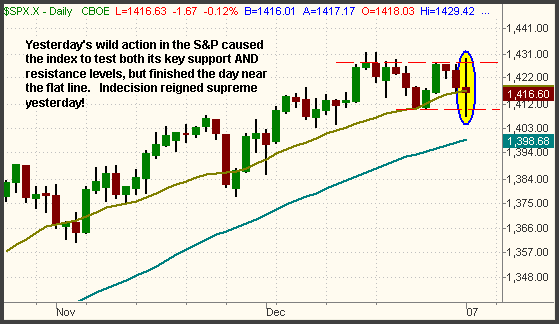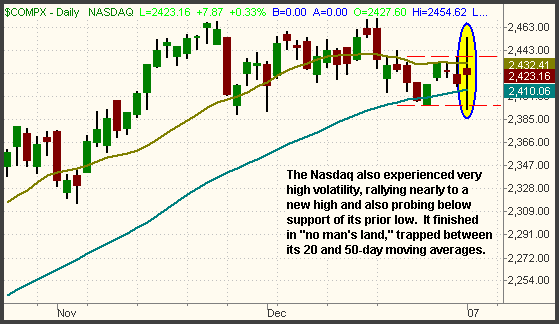Yesterday was a wild session filled with volatile, whipsaw moves in both directions that left the major indices with mixed results. The Nasdaq Composite, with a maximum intraday gain of 1.7% and loss of 0.9%, closed 0.3% higher. Both the S&P 500 and Dow Jones Industrial Average were equally as indecisive, but closed with a loss of 0.1% and a gain of 0.1% respectively. The small-cap Russell 2000 was unchanged, while the S&P Midcap 400 Index advanced 0.4%. If you missed the intraday trading action and only saw the final closing figures in the news, you might have assumed yesterday was a relatively uneventful day, but it certainly wasn't! Instead, it was an erratic, high momentum tug-of-war between the bulls and bears. Since each of the major indices finished in the bottom half of their intraday ranges, the bears slightly had the upper hand in the end, but not overwhelmingly.
As one might expect, the conclusion of the holiday season and the four-day weekend caused volume to rocket higher across the board. In the NYSE, total volume was a whopping 102% higher than last Friday's level! Total volume in the Nasdaq surged 88% higher. The NYSE saw its highest volume since September 15, the "quadruple witching" options expiration day for the third quarter of last year. Nasdaq volume was also way above average. The mixed closing prices in the S&P and Nasdaq technically caused the former to register a bearish "distribution day" and the latter a bullish "accumulation day." However, the extreme intraday volatility made it difficult to confirm either scenario. In the morning, advancing volume in the Nasdaq exceeded declining volume by a margin of more than 6 to 1, but the ratio was only positive by less than 2 to 1 at the close. Conversely, the NYSE finished with a negative volume spread of 1.2 to 1. Both institutional buying and selling was at play throughout the day, but the trend of the market internals indicated more overall selling than buying.
In yesterday's newsletter, we noted how both the S&P and Nasdaq were entering the new year at pivotal "make it or break it" levels. Specifically, we mentioned that the stock market's direction over the next month would primarily depend on which scenario occurred first -- a break below the indices' key support levels we illustrated or a breakout above equally important resistance levels. To our surprise, the major indices did both yesterday! In the S&P 500, we pointed out that the November 27 high of 1,427 was the resistance level to watch, while the 20-day MA at 1,416, and especially the December 22 low of 1,410, were key support levels. As you can see by the long "wicks" or "tails" on yesterday's candlestick, the range of the S&P exceeded both extremes yesterday, but settled near the middle of its range:

In the Nasdaq Composite, we highlighted the December 29 high of 2,437 as being a pivotal resistance level because a rally above that area would also put the index back above its 20-day MA. Conversely, we anticipated a break below support of the 50-day MA at the 2,410 area would lead to a rapid break below the December 26 low. Like the S&P, the Nasdaq managed to trigger both those support and resistance levels in yesterday's session before closing in "no man's land." Take a look:

Yesterday's candlestick patterns in both the S&P and Nasdaq consisted of a narrow body, but with long "wicks" or "tails" on both sides of the body. This type of pattern is known as a "long-legged doji" candlestick and it indicates the market was very indecisive. For this type of pattern to form, the stock or index must have traded well above and below the opening price level, but close the session near that opening price. Basically, the bulls and bears battled it out, but no clear winner emerged in the end.
Commodities, especially crude oil, experienced significant weakness yesterday. Spot gold dropped sharply, but our trailing stop strategy still enabled us to lock in a gain of more than 1.5 points on our GLD position. We also registered a gain of nearly 3.5 points when the afternoon slide in the Nasdaq 100 Index caused our long position in the UltraShort QQQ ProShares (QID) to hit its dividend-adjusted profit target. We still remain long the UltraShort S&P Midcap ProShares (MZZ), which has been hovering near the flat line since our entry point. We also bought a new position in the UltraShort S&P 500 ProShares (SDS) when the S&P broke below its primary uptrend line yesterday. The market's recovery in the last hour of trading caused SDS to move 50 cents against us, but we still like the trade as long as the S&P does not break out above yesterday's high.
Going into today, new support and resistance in the S&P and Nasdaq will simply be equal to yesterday's lows and highs in both indices. Support for the S&P is at 1,407, while resistance of the high is at 1,429. For the Nasdaq Composite, those levels are 2,394 and 2,454. As long as both indices stay within those price ranges, be careful out there because it's bound to be choppy!
Fortunately, the type of trading action we experienced yesterday is relatively uncommon, but the bad news is that such conditions can result in rapid losses to your trading account if you lack discipline. Obviously, nobody knows how long it will take for the market to resolve itself in one direction or the other, so it is imperative that you take steps to protect yourself from substantial losses in such a whippy environment. We suggest reducing your share size on all new positions and also using mechanical stop orders if you have trouble pulling the trigger and cutting your losses in volatile markets.
Deron Wagner is the Founder and Head Trader of both Morpheus Capital LP, a U.S. hedge fund, and Morpheus Trading Group, a trader education firm launched in 2001 that provides daily technical analysis of the leading ETFs and stocks. For a free trial to the full version of The Wagner Daily or to learn about Wagner's other services, visit MorpheusTrading.com or send an e-mail to deron@morpheustrading.com.